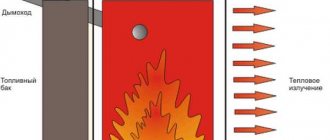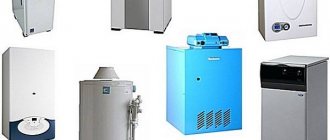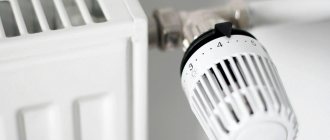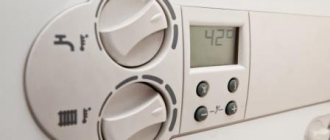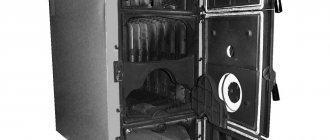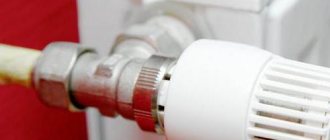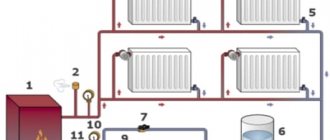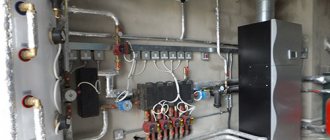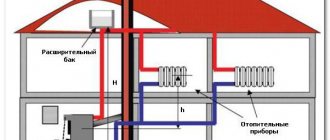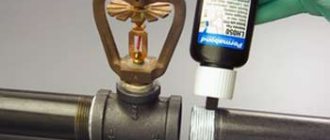In private homes, the main source of heat is a heating boiler. In order to control the heating process of the equipment, a temperature sensor is needed for the heating boiler. It is on its normal operation that both the comfort throughout the house and the safety of the heating equipment largely depend.
Design and principle of operation
Heating boilers can be supplemented with temperature sensors, both internal and external (remote).
The built-in ones are responsible for adjusting the heating installation depending on the temperature of the liquid inside the heating system.
External ones help to adjust the operation of the heating installation in accordance with the readings of either room or street temperature. The joint use of a pair of such sensors makes it possible to more accurately regulate the operation of the boiler installation, which means there is energy saving when weather conditions change.
The operation of the devices consists of constant measurement of processes:
- resistance;
- pressure;
- thermal expansion.
Which are in direct connection with the temperature of the heating system filler.
Automatic thermostats work according to the program embedded in them, controlling the operation of heating devices.
Mechanical controllers, when exposed to high temperatures, are capable of changing their thermal conductivity by closing/opening the connections of the corresponding valves.
All temperature sensors are placed in a special, small-sized block housing with installation directly into the heating structure.
The results obtained can be transmitted over a wireless communication channel, such as WI-Fi, or transmitted over wires.
Both electric and solid fuel boilers can be controlled by temperature sensors.
The programming function using a thermal relay paired with temperature sensors allows you to automate the procedure for adjusting the heating system. In addition, this makes it possible to significantly reduce heating costs.
In general, the entire structure can be equipped with three temperature monitoring devices:
- Indoor.
- Street.
- For water-based underfloor heating systems.
Classification of types of temperature sensors
In order to choose the right boiler temperature sensor, you need to know where it (temperature) will be controlled:
- from inside the boiler plant;
- ambient air temperature in the rooms;
- coolant inside the heating structure itself.
The correct installation location of the meter affects not only the efficient operation of boiler equipment, but also the safety of its use.
There are two main criteria by which the temperature sensor is selected correctly:
- How is temperature determined?
- How the sensor interacts with the thermostat.
Types of sensors by method of determining temperature
There are several ways to measure temperature:
- Dilatometric. It is directly dependent on the state of the bimetallic plate with a large coefficient of thermal expansion, which can expand under the influence of heat. Magnets specially placed inside increase the sensitivity of the sensor.
- Thermoelectric. It consists of a pair of dissimilar conductors, which, during thermal expansion, are capable of producing thermo-emf. It is distinguished by increased accuracy due to the fact that the length and cross-section of the cables do not have a significant impact on the measurement result.
- Manometric. They measure how much the state of liquids or gases in a certain limited volume changes when heated.
- Resistive. Special alloys with high thermal expansion are used. They are sensitive to the slightest temperature changes. Usually presented in the form of a coil with copper-plated wire, placed in a plastic case.
- Semiconductor. Available in two versions:
- nonlinear temperature thermistors with a simultaneous decrease in resistance when heated;
- posistors with a nonlinear dependence, which is expressed in an increase in the resistance coefficient when heated.
Types of contact sensors
A special temperature sensor for the boiler can be connected to the equipment in two ways:
- using wires through which temperature data is transmitted to the control controller;
- using wireless technology. They operate on a dedicated radio frequency.
But it should be taken into account that there are no miniature wireless devices for heating systems. To power the device, read information and simultaneously transmit a signal, a control controller is required. Therefore, a wireless thermostat can only be paired with a room sensor. And the temperature sensor itself is for small-sized boiler equipment.
Temperature sensor for boiler, types and characteristics
Temperature sensors for a boiler are one of the auxiliary automation elements for controlling a heating system, allowing one to determine the temperature of the environment in which the sensor is installed and automatically adjust the heating power of the boiler in order to create a temperature regime acceptable to the home owner.
Types of sensors
Depending on the functions performed:
- air temperature measurement, used to transmit temperature readings to the control system to adjust the boiler power, increasing or decreasing it, depending on the transmitted data, the following can be set :
- in room.
- outside the premises, they work in tandem with weather-dependent generators of boilers located outside the residential area, in outbuildings.
- coolant temperature measurements, measure the actual temperature in the heating system, depending on the installation method they differ in :
- Superimposed, attached to the heating circuit pipes using various devices
- Immersed, they measure the temperature in direct contact with the coolant.
Depending on the type of connection with the control system
- Remote, operate using a radio signal, the design includes: a transmitter and a receiver.
- Wired, communication using wires.
Types from manufacturers
Temperature sensors for the Proterm boiler, from a Czech manufacturer, are presented in the form:
- External electronic temperature controllers for Proterm boilers, in the system of weather correction of heating circuit temperature , depending on the boiler models, are divided into series :
- S010075 for boilers Tiger V 17 and Bear KLZ, KLOM, Panther V 18,19, Cheetah; Skat V 13
- QAC 31/101, consists of a sensitive element NTC575 Ohm at 20 C°, the model reduces the influence of extraneous factors (wind, sun, wall temperature) on the sensor reading.
- Thermolink B room controllers, transmitting room temperature readings for subsequent adjustment of the heating system, equipped with eBus communication, frost protection and self-diagnosis system
- Submersible sensors SO Proterm Leopard M17
S010075
boiler temperature sensors
from the largest German manufacturer are presented as:
- NTS circuit temperature measurement, immersed type: Vitopend WH1B, WH1D (wall-mounted), Vitodens 200 WB2B (condensing)
- Submersible type Viessmann 7819968, principle of directly proportional increase in temperature with decrease in pressure, 10 kOhm -25C°; NL500 series
NL500
- Outside temperature measurements Z006506, for weather-compensated module.
- Exhaust gas temperature measurements for Vitopend WH1B, WH1D
Note!
The sensors for the Visman boiler are unique and cannot be replaced by other types.
Temperature sensors for the Ferroli boiler
from the Italian manufacturer are presented as :
- Surface-mounted type for Ferroli Domitech / Domiproject / Divatech / Divatop boilers
- Outdoor outdoor type
- Ambient air temperature sensors for boilers Fer / Ferroli Domicompact, Diva, Domina C13-32 N / Arena CF13-24
Waybill sensor
The Evan company presents products in the form of electric boilers of the main or reserve type, with a connected sensor that controls the temperature of the coolant of the main boiler and if it decreases, the automatic connection of the Evan electric boiler is triggered.
Boiler sensor Evan
Temperature sensors for gas boilers, electric and other types are similar in structure and principle of operation, differences in connection methods.
Where can I buy
The list of contacts of selling companies offering to buy a temperature sensor for a boiler running on natural or liquefied gas can be viewed in the table below.
A wide selection of weather controls and room thermostats for gas boilers of various brands.
- Location:
st. Oktyabrskaya 5, Tula - Call here:
+7 (4872) 793 051 - Find out more:
https://www.teploservice-ovk.ru/
Offers to buy a Vaillant and Protherm gas boiler temperature sensor (external).
- Location:
st. Vavilova 64, Rostov-on-Don - Call here:
+7 (863) 27 077 92 - Find out more:
https://teplolab.com/
Where can I buy
Electronics for heating boilers are available for purchase in specialized stores in your city. But there is another option that has recently received significant improvements. You no longer need to wait a long time for a parcel from China: the AliExpress online store now offers the opportunity to ship from transshipment warehouses located in various countries. For example, when ordering, you can specify the “Delivery from the Russian Federation” option.
Follow the links and choose:
| Thermostat for gas boiler with Wi-Fi and remote control, 3A | Smart Wi-Fi thermostat Tuya for boiler | Smart Wi-Fi Touch Thermostat, Wireless |
| Digital LCD Thermometer with Water Temperature Gauge | BGL02-5 LCD display thermostat for gas boiler | Intelligent Thermostat, Temperature Controller |
Placements
Naturally, the sensor must be placed in the zone of influence of the heater. Therefore, they are distinguished by the method of placement:
- overhead - installed with tight contact directly on the heated surface;
- submersible - placed inside the coolant;
- room - the room temperature is controlled;
- external - the state of the external environment outside the house is measured. They have a waterproof body.
Remote heating control from a GSM smartphone
Often, owners of country houses would like to control heating costs by remotely controlling the temperature in their home, and also be aware of the operation of heating equipment; they would like to be notified in a timely manner about all emergency situations and changes in operating modes. To maintain a comfortable temperature in the room, you just need to adjust the parameters of the heating boiler, but the problem is that you are not at home and you simply cannot go to the boiler and turn the switch. For example: when you are going to come to the dacha, it’s enough to “flood” it a little, and in your absence, reduce the heating power - why throw money away heating an empty house? GSM heating control is popular among home owners who are not equipped with wired Internet (or its quality is unsatisfactory) and, accordingly, do not have the opportunity to use home Wi-Fi networks. Almost the only solution in this case is remote monitoring and control of the heating system via a GSM channel.
The sensor controls the boiler
In order to more fully ensure comfortable living in a house with a minimum of thermal energy consumption, various devices are used. Such a temperature sensor for a gas boiler allows it to be programmed for different operating modes. The user just has to set the necessary parameters.
Mechanical thermostats
These models are the simplest. Without extensive functionality. They work through the use of membrane sensors located in a sealed capsule filled with liquid. When heated, the liquid expands and at a certain temperature puts pressure on the membrane and the thermostat makes it clear to the heating boiler that the power can be reduced/increased.
Mechanical devices are equipped with an expressive temperature selection dial. Due to their 3-4° accuracy and the wired connection method, these regulators are inexpensive.
Electromechanical
A slightly improved version of the previous temperature controller - electromechanical devices.
The principle of temperature regulation is similar to mechanics, but the operating principle is slightly different. The design uses heat-sensitive metals. When the heating changes, a micro-discharge is created or the resistance changes.
There are models with a small display for heating control and the possibility of adjustments in reduced steps. These changes were reflected in a slight increase in the accuracy of the device and in its price - it became more expensive than mechanics.
Electronic
More accurate electronic models are the most popular. These are more modern thermostats. They are multifunctional and easy to use.
- Can be used in conjunction with underfloor heating temperature sensors.
- Possibility of programming.
- There is protection against overheating and freezing.
- Warns that the circulation pump has stopped working.
- The measurement error is within 0.5–0.7 °C.
More advanced versions are equipped with built-in Wi-Fi for wireless connection to the boiler. Such a wireless room sensor, despite its high price, has a short payback period if used correctly.
Outdoor sensors
Just like internal thermostats, an external sensor allows you to further increase the savings in gas spent on heating the house. For example, if you set the comfortable temperature in your house to 20 degrees Celsius. The geyser will try to maintain this temperature, without taking into account the temperature outside the window.
If at this time it is minus 30-40 outside, which is quite typical for Russia, then the column will fight the cold coming from outside throughout the day, warming up the room for a very long time. This is solved manually or left to the automation, and it is precisely for the automation to work that an external sensor is needed, which will always provide the necessary power for the gas boiler.
A temperature sensor for a gas boiler hanging outside the house is the main power regulator, and at the same time an assistant to the main programmer or thermostat; flexible settings allow the sensor to work effectively.
Remember that the installation of an external meter must be carried out according to all the rules, avoiding direct sunlight on the device, and away from metal surfaces. The sensor should not be influenced by external factors of temperature changes.
YouTube responded with an error: The provided API key has an IP address restriction. The originating IP address of the call (87.236.20.136) violates this restriction.
How to choose a remote temperature sensor
What to look for when buying a temperature sensor? There are several options:
- A temperature meter needs extreme sensitivity and a wide range of measured temperatures. To quickly respond to changes in heating;
- sensor type - submersible or external. Is there a place for installation? It must match the dimensions of the water heater;
- temperature sensor parameters. Is there a need for additional voltage? At what speed is the signal transmitted and with what error. Ability to work in the right conditions;
- service life, maintenance frequency, need for additional calibrations;
- output signal level;
- permissible current, resistance, etc.;
When going to the store to buy a new device, it is better to take with you the technical data sheet for the heating installation.
Paired with thermostat
See how the temperature sensors will work with the boiler - with thermostat support or directly.
Many modern thermostats have the ability to adjust heating control depending on the weather. In this case, the power of the heating installation can be adjusted automatically if the thermostat is paired with an outdoor temperature sensor.
An outdoor thermostat is a single structure consisting of the sensor itself and a long (2–6 meters) wire for connection to the thermostat.
Should be considered:
- in what temperature range can the sensor for a gas boiler operate;
- level of moisture protection;
- the magnitude of the error in indoor air measurements. Permissible ± 1 °C. Good ± 0.5 °C;
- connecting cable length. Out of the box there is a wire up to 6 meters long with an attached temperature sensor.
Direct connection to the boiler
As a rule, those boilers that are purchased are already equipped with temperature meters and they are developed by the same supplier. If you want to install remote control of the boiler using a controller, you need a cable (usually two-wire). But you need to buy it yourself. The wire cross-section and resistance can be found in the instructions for the sensor.
They are usually connected to a thermostat. When automatically controlling the operation of boiler equipment, the connection is made to the controller, which brings the boiler to operating modes.
In any case, the connection is strictly regulated, according to the attached instructions.
Additional control devices, if necessary, can be recommended by the manufacturer of the boiler apparatus. This way you can guarantee the compatibility of devices and their correct operation.
If at the time of purchase the factory-recommended sensor for a gas boiler is not available, it must be replaced with certified analogues.
Outdoor sensor connection
An outdoor temperature sensor for boiler equipment is mounted on the outside of the building wall, subject to the following conditions:
- the temperature sensor should not be directly heated by the sun;
- the wall of the premises building should not be sheathed with metal;
- exclude the laying of cable lines in places where there is a possibility of rainfall;
- avoid contact with chemicals that may damage the insulation;
- the maximum height for placing a temperature sensor is 2/3 of the height of the house;
- exclude the influence of extraneous factors that may affect the external temperature sensor.
- protect the wire with an additional corrugated tube;
An external temperature sensor is connected, observing the polarity, when the boiler is not supplied with power. The main condition is that the cable with a cross-section of 0.5 mm² must be solid, and the length should not exceed 30 meters. The places where the cable is connected to the boiler and the meter must be insulated and sealed.
After connection, the quality of installation work is checked and the thermostat is adjusted. Additional inspection may reveal errors. In this case, a complete rework is required. Improper installation of an outdoor sensor can lead to either failure of the boiler equipment or poor heating of the premises.
Connecting the sensor inside the building
A room temperature sensor for a gas boiler is installed from the inside of the room on the outer wall, without violating the following conditions:
- Avoid being near heaters or air conditioners.
- Free access to the interior space. Eliminate all interior items that obscure the room sensor.
- The permissible height is 1.2–1.5 meters from the floor.
- There should be no nearby electrical wiring.
The method of connecting the device to boiler equipment is similar to an external temperature sensor.
Connecting a temperature sensor for a gas boiler
The temperature sensor for the gas boiler must be installed on the controller itself. As an option, installation on a gas valve is allowed.
Sequence of actions for self-connection:
- The instructions for the gas boiler must include a diagram. It contains the heating boiler itself and the place where the device is connected, its markings and the location of the contacts.
- Now on the gas heater itself you need to remove the front panel. It blocks access to the board and contacts.
- You need to remove the factory jumper between the terminals.
- Connect the wires from the sensor contacts to these terminals. The polarity of the wires does not matter.
- If a wireless air temperature sensor is installed to the relay unit, connect a three-wire wire with 220 V grounding.
If there are any doubts about the correct installation, it is recommended to refer again to the instructions for the gas boiler.
Operating and safety features
Thermal sensors help improve the microclimate, but their normal operation depends on following simple rules:
- the element itself that measures room temperatures must be immersed as much as possible in the environment where it is necessary to improve heat transfer;
- Correct and long-term service of the room temperature detector depends on timely inspection and calibration in full accordance with the recommendations from the manufacturers;
- eliminate the negative impact of external factors that may affect the accuracy of temperature measurements for boilers;
- Operation of electrical sensors with damaged insulation is prohibited;
- Do-it-yourself disassembly of the thermostat is strictly prohibited;
- All preventative work is carried out with the equipment disconnected from the 220V network.
Features of operation
When operating temperature sensors, you must follow the following rules:
- the sensitive element must have maximum contact with the heat exchange medium;
- maintenance and calibration must be carried out in accordance with the manufacturers' recommendations;
- It is important to exclude negative external influences that may affect the measurement results.
Thermal sensors for boilers are quite easy to select and relatively simple to install and connect. To do this, it is important to follow the connection instructions and perform all installation steps sequentially.
Replacement and connection
If the thermostat breaks down, then finding out the source of the breakdown is not difficult at all and can be done by the owner of the heating installation:
- If the water does not heat up, the source of the disease lies in both the temperature sensor and the thermostat. In this case, we do not consider the breakdown of the heating element. We assume that it is working properly.
- The temperature sensor is removed from the boiler and all wires are checked for breaks using a tester in the “continuity” mode.
- If the temperature measurements show zero when the thermostat is running, it is definitely faulty. You can’t fix it yourself; it’s better to buy a new one and replace it.
- If the thermostat responds to the boiler in the “call” mode, you need to set the minimum temperature value and take measurements again.
- If it is working properly, then in the “heating” mode its contacts should be open, and the resistance at the input and output should increase.
Replacing the thermostat with a similar one is described in detail in the instructions for the heater. If there is no such thing on sale, a similar one with the appropriate parameters is looked for.
